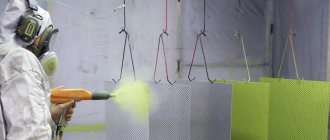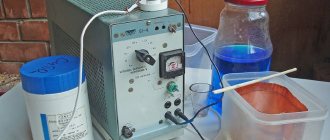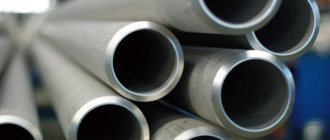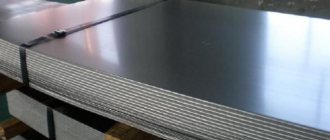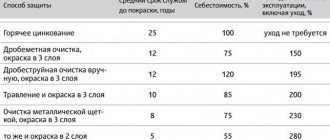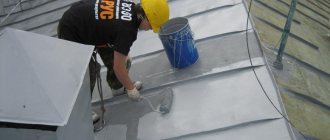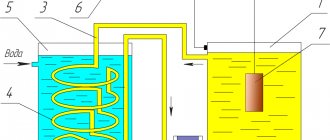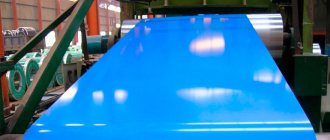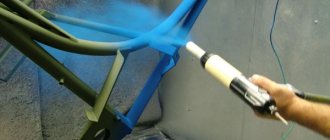Metalprofile Plant LLC carries out painting of galvanized coiled steel using high-tech equipment from Bronx (Australia), one of the international leaders in the development and production of technological lines and equipment for processing galvanized coiled metal.
A modern high-tech automatic painting line ensures high quality coating application, and its capacity allows it to satisfy the needs of the company itself and provide painting services to third-party customers.
To purchase painted coiled steel of any color according to the RAL catalog in Ulyanovsk, just call 58-78-97, 37-05-63, 37-05-64.
We paint galvanized steel coils from leading Russian manufacturers such as NLMK, MMK, Severstal and use only high-quality enamels from reliable manufacturers.
The line can paint galvanized steel with a thickness of 0.3 to 0.8 mm. At the same time, the technology allows you to obtain many different colors.
Coil metal is painted using the innovative coil coating method, which guarantees high quality and allows you to obtain uniform thickness along the entire length of the roll.
Galvanized steel with polymer coating is used in many industrial sectors. It is an environmentally friendly, modern and durable material that has an aesthetic appearance and is distinguished by high technological characteristics. Thanks to the application of a polymer coating, the metal is not subject to corrosion, is resistant to mechanical damage and atmospheric influences (moisture, ultraviolet radiation, temperature changes, etc.)
The coating perfectly withstands a wide variety of mechanical deformations (stamping, cutting, drawing, cutting, etc.). This allows us to produce products such as corrugated sheets, sandwich panels, additional elements, drainage systems, etc.
About production
Painted steel coils are produced using automated equipment. To obtain high-quality material, the process of applying a polymer layer is carried out in the following sequence:
- the steel is placed in a container with rotating brushes, where the surface is degreased;
- the applied composition is washed off twice with water coming from the nozzles;
- surface passivation with chromium composition;
- drying metal with hot air;
- A primer is applied to the surface using the roller method;
- the product is dried in an oven at a certain temperature;
- using rollers, a coloring composition is applied to the surface;
- the polymer layer is dried in an oven;
- the finished product is wound into a roll;
- rolls are packaged to preserve the surface during transportation and storage.
If the technology of applying color coating is followed, the decorative appearance is improved and the anti-corrosion properties of the material are increased.
Polyester cover
Polyester is the most commonly used coating for corrugated sheets. It is cheap, durable, and well resistant to negative environmental factors.
Advantages:
- UV resistance – the material does not fade in the sun and retains its original appearance for a long time;
- corrosion resistance;
- resistance to temperature changes;
- low price.
The main disadvantage is the small thickness of the applied coating, so it may not be particularly durable. To ensure the quality of the material, you need to carefully bend the corner of the sheet: if no cracks or small folds appear, then the corrugated sheet will last a long time.
The material coated with matte polyester wins in terms of durability. The technology involves applying the coating unevenly. The thickness of the spraying will be slightly greater than in the case of glossy polyester, and therefore the strength properties increase. Such a profiled sheet often receives a surface simulating brickwork, wood or stone.
Types of polymer coatings
Protective and decorative coating for rolled steel is applied using materials based on organic polymers, which contain special additives, solvents and coloring pigments. There are two types of coloring compounds: thermosetting and thermoplastic. The most commonly used types are:
- Polyurethane. Layer thickness – 50 microns. Matte finish, resistant to temperature changes, intense lighting and chemical compounds.
- Polyester (PE, SP). Layer thickness – 25 microns. Inexpensive material, resistant to corrosion and UV radiation. Does not react to temperature changes, resistant to mechanical stress. Retains its properties in the temperature range from +120 to -60 degrees.
- PVDF. Layer thickness – 27 microns. The composition consists of polyvinyl chloride with the addition of acrylic. The most durable coating against mechanical damage and sunlight.
- Plastisol (PVS-200). Layer thickness – 200 microns. Embossed covering. The composition includes polyvinyl chloride and a plasticizer. The material is resistant to mechanical damage; it is not recommended to allow heating under sunlight above 80 degrees.
Source
Powder painting technology
Powder paint melts when the temperature rises. At the same time, polymerization of the paint occurs. After this process, the powder coating layer cannot be melted.
The thickness of the powder coating coating for decorative purposes ranges from 20 to 80 microns. The thickness of the coating for functional purposes can range from a few microns to several millimeters, depending on the application. Such functional coatings are used for the production of polymer-coated corrugated sheets and metal tiles.
Modern lines for painting coiled metal
The metal has unique performance properties, such as strength and ductility, electrical conductivity and fire resistance. Without him, the development of technology would be unthinkable. Modern construction, mechanical engineering, automotive industry and other key industries are based on the use of metal as the main structural element.
Protecting the surface from corrosion and the environment is an important element of working with metal; paints and varnishes, anodizing and galvanizing, silver plating and gilding are used for this. However, all of these coatings have significant disadvantages: they are either expensive and problematic to use, or short-lived. An effective solution to the problem was the modern Coil Coating technology, which is produced by applying polymer coatings to the metal surface.
How to choose paint
Polymer paint is chosen depending on the type of work, product and place of its further use. To decorate elements in the room, choose environmentally friendly dyes without a strong odor. To paint surfaces that will be used outside, polymer paints must be resistant to moisture, sun, and dust. It is recommended to choose quick-drying types of powder dyes. In addition, metal products require paints that protect against corrosion. You also need to decide which surface suits you - glossy or matte. Glossy is easier to clean and more practical. But matte can mask minor defects on the metal surface. You definitely need to look at the expiration date - the closer it is to the manufacturing date, the better.
Coil Coating metal painting technologies
Coil Coating or roll coating -
This is a high-tech method of carrying out painting work, when the application of paint and varnish coatings is carried out on automated production lines. This technology was invented 60 years ago in the USA and is currently widespread throughout the world.
The technological process of painting coiled metal is represented by the following stages:
1. Surface preparation before painting.
- double degreasing of the sheet surface followed by double rinsing with clean water;
- passivation of the sheet surface with a special chromating solution followed by drying with hot air.
2. Coloring the sheet.
- applying a primer;
- drying the primer layer in a drying chamber;
- application of enamel;
- drying enamel in a drying chamber;
- winding painted metal sheets into rolls.
What is galvanized steel
Galvanized steel is steel that has been galvanized, that is, a thin layer of another metal material has been applied to it through production. This reduces the electrode potential of zinc. This process helps to obtain additional properties from the material:
- Mechanical protection from environmental factors;
- Electrochemical. Thanks to the treatment, damage to the zinc layer does not lead to the harmful effects of corrosive formations.
Thanks to the treatment, damage to the zinc layer does not lead to the harmful effects of corrosive formations.
Rolled metal painting line
Standard metal painting lines consist of many technical components, each of which is responsible for specific actions:
- unwinding and rewinding devices;
- welding machine;
- a painting booth with automatic control, through which painting operations will be carried out;
- cooling elements that regulate the microclimate in the painting booth and prevent equipment overheating;
- a drying chamber into which the painted metal is moved for subsequent drying;
- a transport line that ensures the movement of rolled materials throughout the paint shop.
Dimensions of finished coil of painted steel in packaging
| Inner diameter, | mm | Outer diameter, mm |
| min | max | max |
| 508 | 610 | 1400 |
To purchase rolled steel, please contact the sales department by phone: 58-78-97, 37-05-63, 37-05-64
Our managers are waiting for you!
Galvanized steel coil painting lines
As a raw material, galvanized steel is used in a large number of industries. This is an environmentally friendly, durable material that has high technical characteristics. The application of a polymer coating makes the steel resistant to corrosion, damage and various temperatures.
For this purpose, the production uses a steel coil painting line. It automatically applies polymer paint and varnish coatings to the material. This process provides a decorative finish to the steel and provides effective corrosion protection. The main advantage of polymer coating is the ability to process steel into finished products without damaging the paint film. Thanks to this, the coating can withstand a wide variety of mechanical deformations (stamping, cutting, drawing, cutting).
Advantages of polymer paints
Powder dyes have a number of advantages, due to which they can be used to process external and internal products made of different types of metal. The advantages of polymers include: - they are not afraid of mechanical damage: if the metal product is damaged or deformed, the color will simply take a new shape, remaining on the surface; — water and moisture resistance: the polymer coating does not lose its qualities, even if the product is in or under water for a long time; - resistance to UV rays: while other types of paints from sunlight can fade, collapse and lose all their properties, the polymer coating will remain just as durable and bright, nothing will happen to it even on the sunniest day; — can withstand fire and high temperatures: since polymer painting is carried out under strong thermal influence, the coating is not afraid of high temperatures in the future; You can even use powder paint to paint your grill and heating boiler. - not destroyed by chemicals.
Applications for coiled steel
Color coated steel coils are widely used as raw materials in major industries such as:
- defense production;
- aviation production;
- mechanical engineering;
- shipbuilding;
- automotive industry;
- construction of residential buildings and public facilities;
- production of household appliances.
The undoubted advantages of galvanized steel coils are light weight, long service life, wear resistance and practicality. Thanks to such impressive characteristics, three-dimensional parts and structures can be made from it. The market for the production and sale of painted galvanized steel coils is developing at a rapid pace, and at present it is difficult to imagine an industrial sector in which this material would not be used.
Scope of dyeing
Polymer dyes are used to process metal products for external and internal use. Polymer-based paints are used to cover pipelines, metal floors, elements of warehouses and ships. Paint is used not only as a decorative surface decoration, but also as a protective coating - for example, metal structures in swimming pools that are constantly in contact with water are painted. Polymer paint is used to paint cars, household appliances (bathtubs, boilers, boilers, refrigerators), and to process elements of bridges and viaducts, buildings and other metal structures.
Advantages of the painting line
Coating lines for rolled material have become very popular and can increasingly be found at large production sites. The main advantage of this equipment is the ability to perform the production cycle without stopping. In addition, coiled steel painting lines are characterized by an impressive list of advantages, including:
- Operational benefits. The painting produced in the chamber is characterized by a high level of adhesion and coloring quality. In addition, thanks to the design features, the paintwork can last at least 10 years.
- The painting process on the line for rolled materials is carried out in compliance with all necessary requirements, which allows you to create a durable and reliable coating that significantly improves the technical characteristics of steel.
- Coloring of rolled material allows you to reduce the cost of production by 15-20%, which affects the cost of the product.
- Thanks to the use of specialized painting lines, you can significantly save on energy. The equipment is equipped with special sensors that allow more economical use of electricity, thereby helping to reduce costs.
Painting lines have quite significant dimensions, which allows you to work with large-sized steel rolls. If necessary, the line can be equipped with additional components for decorative coloring of rolled materials.
It is profitable to purchase a steel coil painting line
You can do this on our website. SPK is a unique engineering company that is the largest manufacturer of equipment for painting production. Our products meet the highest quality requirements, as efficient and reliable German SIEMENS equipment is used for their production.
Pural coating
Pural (aka armakor) is a relatively new type of material, made on the basis of polyurethane, to which acrylic and polyamide are added. Even though the coating is applied with a thickness of about 50 microns , it is very strong and durable.
Advantages:
- durability up to 50 years;
- preservation of decorative and protective qualities throughout the entire service life;
- resistance to mechanical loads, temperature changes, negative influences of natural and man-made nature.
drawback - the high price, but in areas with high humidity, polluted air and other factors that are aggressive to metal, this is almost the only option.
How to paint coiled steel
The technology for applying a polymer coating consists of chemically preparing the strip, applying paint to the strip, and heat treating the strip to polymerize (fix) the paint.
The challenge is to apply the coating evenly in a short process, achieving a uniform surface and the required coating thickness.
Coiled steel is painted on automated lines using the roller method. Enamels from various companies are used to paint rolled products. Using the hot laminating method, it is possible to apply a protective film in order to preserve the decorative coating.
The choice of rolled material directly affects the processing properties and corrosion resistance of polymer-coated products. For good corrosion resistance, a thicker layer of zinc coating is the best choice. On the other hand, if the main requirement for the metal is the ability to deep profile without becoming brittle, it is better to use a thin and elastic zinc coating that is resistant to cracks.
Surface treatment, carried out at the beginning of the technological cycle before applying a layer of polymer coating, ensures good adhesion between the primer layer and the metal base. The primer is applied mainly to increase the adhesion of the polymer coating and the base, as well as to improve elasticity and corrosion resistance. The polymer coating of the front side and the self-adhesive film, if used, provide the necessary surface characteristics, such as surface appearance (color, texture, gloss, appearance), strength and resistance to abrasion and ultraviolet radiation. Depending on the requirements, it is possible to apply only primer or primer with a polymer coating on one or both sides of the sheet.
There are two main continuous coating methods: roller (liquid coatings) and electrostatic (powder coatings). These technologies will be discussed in more detail in the following parts of the chapter. Below are the characteristics of the production lines that Russian enterprises currently have.
Surface preparation
Before applying a polymer coating to the surface of a metal product, it must be prepared. This is necessary so that the paint lays evenly, does not create a lump, and hardens quickly. When preparing a product for polymer painting, the master must clean the surface, remove all defects, remove grease and oil stains. If the product is old, then first you need to get rid of the remnants of previous painting and remove corrosion products. Cleaning and preparation of metal products is carried out by mechanical, thermal and chemical methods. Purpose of preparation: the finished surface should become as compatible as possible with the polymer coating, without losing its properties and qualities and not reducing the protective quality of the paint.
Source of the article: https://pzo.ru/metalloobrabotka/poroshkovaya-pokraska/polimernaya-pokraska-metalla
Price list
| Surface volume | Cost of work including paint and packaging (per linear meter) | Cost of customer's paint work (per linear meter) |
| up to 100 m² | 240 rub. | 180 rub. |
| from 101 to 300 m² | 230 rub. | 173 rub. |
| from 301 to 500 m² | 220 rub. | 165 rub. |
| from 501 to 1000 m² | 215 rub. | 160 rub. |
| from 1000 m² | Calculated individually | 140 rub. |
Request for painting
Painting technology
To paint this material at home yourself, first study the advice from the manufacturer on the paint packaging, then the process will be more clear and simple. To understand how to paint iron without the paint flying off, you need to study all the stages of the work.
To understand how to paint iron without the paint flying off, you need to study all the stages of the work.
Preparing for painting
An important step is preparing the surface of galvanized steel; it must be treated to obtain a high adhesion index. You can use abrasive coating for this purpose. If the material was left outside for at least a year, the oxidation process occurred naturally. However, it should still be cleaned of contaminants and degreased.
It is advisable to purchase all the materials that will be used from the same company; their properties match each other perfectly.
The metal should be cleaned of contaminants and degreased.
Creating a protective layer on the surface
If the coating has been painted previously, the old layer of paint will be removed. Cleaning can be done using thinner and a wire brush. The process must be carried out carefully to preserve the zinc layer on the steel. Then the surface is cleaned again.
Cleaning can be done using thinner and a wire brush.
Painting galvanized metal
First, the paintwork materials are mixed and some are transferred to a cuvette. The tools for work can be brushes, rollers, or a spray bottle. Before painting a new layer, make sure that the previous one is completely dry. It is recommended to apply two layers; if you want to get a bright finish, you can paint in three layers.
Before painting a new layer, make sure that the previous one is completely dry.
Why paint galvanized steel?
Before painting galvanized iron, it is advisable to understand for what purpose it is being done. The protective zinc layer is thin, which after some time leads to corrosion processes with the zinc itself. The result is white marks, which are called “white rust.” As a result, the coating looks unsightly, and the steel itself becomes defenseless against environmental factors.
Galvanizing is regularly used to cover the roof so that its surface can last longer.
It is important to choose the right way to paint galvanized steel so that the paint does not peel off. This will be discussed below.
It is important to choose the right way to paint galvanized steel so that the paint does not peel off.
